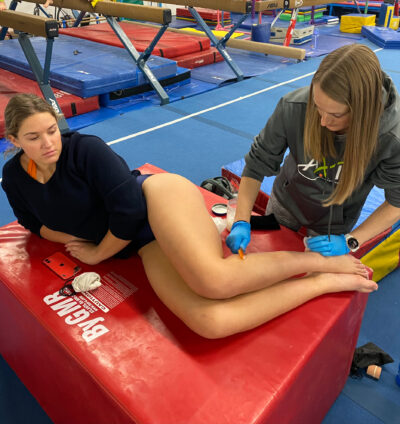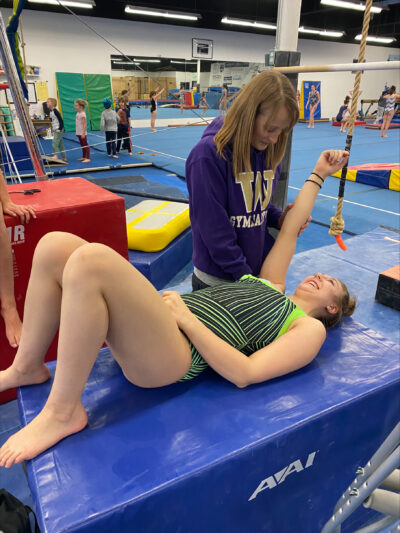
Dr. Kaysha Bates on what it is like to work as a PT in the unique setting of a gymnastics gym.
Working as a physical therapist in a gym looks quite different than your typical outpatient clinic. In the gym, my role as the PT is to support the athletes and coaches, with the ultimate goal of keeping them healthy and avoiding the injuries we can avoid.
In the gym, my role can be broken down in to four main categories:
- Assess
- Treat
- Manage
- Return to Sport.
Let’s dig into what each of these looks like.
Assess
Being in the gym during practice, provides ample opportunity to access injuries as they occur. Often times coaches will call me over to look at an athlete that has gotten hurt. Other times coaches will send an athlete over to me for a quick assessment to determine how their training may need to be modified for that day. Occasionally, these are major injuries, however, often times they are aches, pains, and overuse injuries we are trying to manage well. If injuries are in need of further medical attention, I direct the gymnast and the parents to go see a physician or PA. If I feel like they need further physical therapy treatment, beyond the basics I can do in the gym, I will request they come see me in the clinic. If they need a rehab program to do on an event they are not training at the moment, I will provide that for them. With the intention of them doing it every practice on the events they are not training until things improve. Finally, sometimes, they just need taping.
Treat
Ideally, I try to avoid pulling kids away from their practice time. Although it does happen occasionally, it’s not my goal. I have set “office hours” before or after practice where I am able to do the majority of my treatments. It often looks like an open physical therapy room with multiple gymnasts being treated and rehabbing all at once. However, if an athlete requires one on one attention, modalities I do not have access to in the gym (such as a laser), or wants a more a private treatment setting, I will see them in the clinic.
The point of having open office hours is to monitor and get ahead of minor injuries before they become major issues. As we all know, gymnasts are not always forthright when something starts to bother them. Often waiting weeks or months before telling a coach. At this point, their knee pain, elbow pain, back pain, or shoulder issues are more serious and have longer recovery periods. If we are able to get ahead of this by addressing that back pain the first week it starts, we can often avoid long term, more serious issues.

This type of system takes time to build, and much time and effort has to be spent developing the trust of both the athletes and coaches you are working with. But it’s an extremely valuable relationship to build. The athletes now understand the importance of telling me when their hamstring gets cranky after a day of a lot of leaping. They know that we can address these issues with treatment for the next week and if necessary slight training modifications. Instead of continuing to train through it and ending up with a proximal hamstring tendinopathy that plagues them all season.
Manage
This system allows me to monitor and manage injuries from week to week much more efficiently. Since I am seeing athletes’ multiple times a week, before or after practice, I am able to keep track of their progress and make immediate adjustments. If someone is doing well and is ready to progress, I can give them the green light to do a little more. On the flip side, if someone is getting worse, or not improving, we can discuss slowing things down to prevent further injury or set back. The gymnasts know that my number one priority is their health, and that is the lens through which I am going to base my clinical decisions off of. However, often times, managing injuries does not mean changing training at all, but rather increasing the intensity or type of treatment that is done on my end as the PT. For someone with a tendinitis or weak shoulder, we may spend more time during those open treatment hours working on strength, stability, flexibility, and posture in order to allow that athlete to continue training.

Return to Sport
This is where my unique background as a gymnast, coach, and physical therapist all come together. When I have an athlete trying to get back from a major injury, we will work together to come up with a 6-8 week return to gymnastics program specific to their injury. We start by writing down all the skills they are training or planning to compete on each event. Next, we create a weekly training plan based off their gym schedule and event rotations. Each day and each event is laid out for them. The gymnast has a specific number of back extensions, landings, hand touches, etc, (whatever is most specific to their injury) that they can do each day. Over successive weeks we progress the difficulty of their skills, the landing surface, and the number of skill repetitions in a gradual way that monitors their workload from week to week making sure they stay in a safe but challenging range. There is always room for coaches to make adjustments. For instance, coaches may switch a series and dismount day, but I really emphasize the importance of keeping the numbers in the range I have established to ensure a smooth and safe return to gymnastics.
Summary
Working in the gym as a PT may not be something we commonly see across the country. However, the benefit it provides to the athletes and coaches is immeasurable. Even if you bring a PT in for 1 hour twice a week, you would be providing a huge service to your athlete’s health and longevity.
Dr. Kaysha Bates DPT is a physical therapist based in Jackson Hole, WY